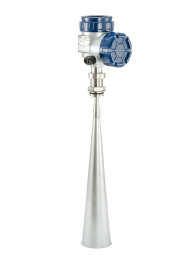Radar type level meter

LRG-10 series
- 2 line system microwave level meter, compact and lightweight.
Because very weak radio signals are used, it can be used without causing interference with other devices. -
Measures levels without contact in harsh environments such as in high temperatures, high pressures, steam, gas, etc. Can be used in public areas, because weak radio signals are used.
Various antennas are available, including cone and process seal types.
Features, keys |Usage, use examples |Standard specifications
Features, keys
- Weak radio signal
Can be used in public areas (rivers, sea, streets, etc.), because weak radio signals are used without any restrictions. - 2-line system
The meter employs a 2-line system, so you do not need to put up new power lines. Just connect to conventional DC lines.
- HART is provided as standard
The meter outputs a HART signal as well as a 4 to 20 mA DC current signal. This makes it possible to connect the meter directly to a computer.
Usages, use examples
- Detect and measure liquid levels continuously without contact
- Measure corrosive and adhesive materials
Ex.: Monitor city water level, sewage, drain liquid, chemical agents (acids, alkalis), slurry, storage tanks, silos, etc.
Standard specifications
Amplifier
| Type | Cone antenna | Process seal antenna |
|---|---|---|
| Power source required | 10.5 to 36V(2-wire system) | 18 to 36V (2-wire system) |
| Operating temperature | -20 to +60 degrees | |
| Current output | 4 to 20mA DC(in Hart multi-drop mode) | 4 to 20mA DC(Hart path) |
| Measurement precision | ± 3mm (0.5m or more | |
| Case material | aluminum die cast | |
| Protection class | IP66 | |
Sensor
| Antenna types | Cone antenna | Process seal antenna | |||
|---|---|---|---|---|---|
| 2B | 4B | 2B | 4B | ||
| Measuring range *1 | 0 to 7m | 0 to 15m | 0 to 7m | 0 to 10m | |
| Antenna material | SUS316L and PTFE | SUS304 and PTFE | |||
| Center frequency | 26GHz | ||||
| Measurement cycle | 1 second | ||||
| Irradiation angle | 18 deg | 8 deg | 18 deg | 8 deg | |
| Tank interior temperature *2 | -40 to +100 degrees | ||||
| Pressure resistant | -0.1 to 1.5 MPa | ||||
*1: The nominal measuring distance is determined by the static water level used as a reflecting mirror. It may become shorter with various measuring conditions. The actual measuring range is determined by each measuring condition.
*2: The operating temperature range varies depending on the O-ring material.
The actual detection area is determined by the measurement conditions.












